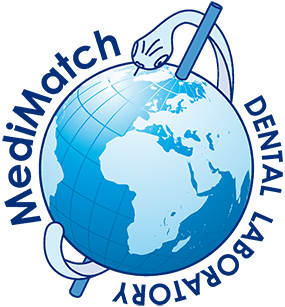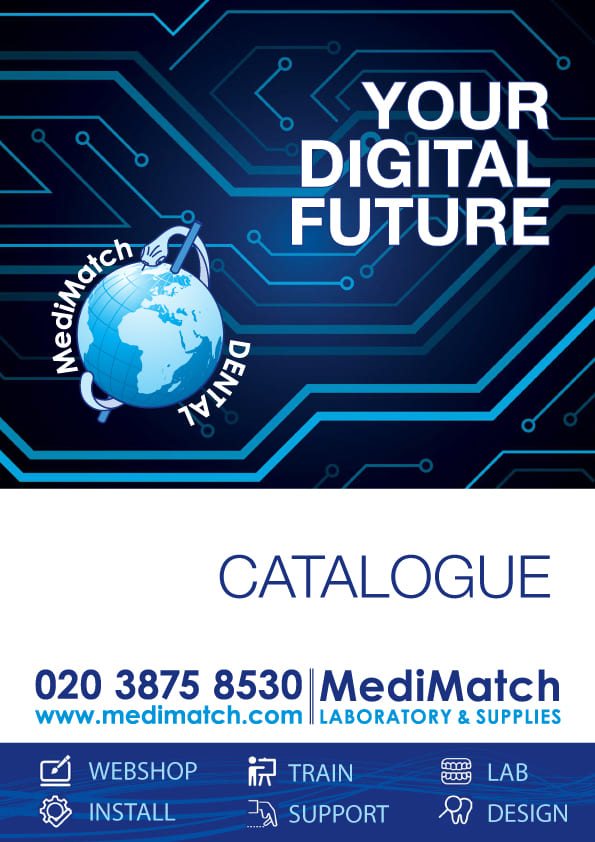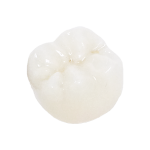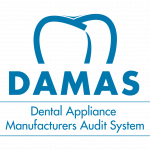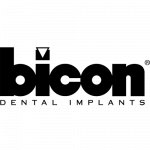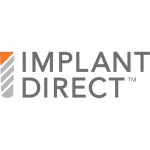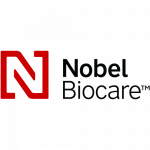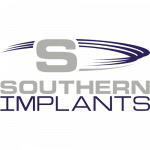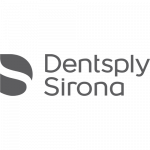Uniblock Zirconia (glaze only)
Dental Uniblock Zirconia is a type of ceramic material that has gained popularity in dentistry due to its strength, durability, and aesthetics. Uniblock Zirconia is a monolithic material, which means it is milled from a single block of Zirconia to create a crown or bridge without the need for additional layers or coatings. This eliminates the risk of chipping or delamination, which can occur with layered materials.
Uniblock Zirconia also has high translucency, allowing it to blend seamlessly with natural teeth. In addition, it is resistant to wear and can withstand the pressure of bruxism or a hard bite. Its aesthetic and functional properties make it a versatile material suitable for a range of restorative dental procedures.
With its excellent mechanical properties and natural appearance, dental Uniblock Zirconia has become a popular choice for patients seeking a long-lasting, lifelike restoration.
| Strength | Aesthetics |
|---|---|
| +++ | + |
Suitable for
Crowns
Inlays
Onlays
Half Crowns
What to send
- Full Arch Silicone impression with wash for working model
- Alginate impression for opposing
- Silicone or wax bite
- Completed lab prescription form
STEP 1 – IN SURGERY
Prepare teeth for zirconia restoration and take impressions and shade match.
STEP 2 – IN LABORATORY
- Cast Models.
- Fabricate zirconia restoration.
STEP 3 – IN SURGERY
Fit restoration.
While dental Uniblock Zirconia is a popular and versatile material, there are some contraindications to its use. Some of the contraindications for dental Uniblock zirconia material include:
- Limited space for the restoration – Due to the strength and durability of Zirconia, it requires more space for the restoration than other materials like composite resin or porcelain.
- Inadequate occlusal clearance – Zirconia requires adequate space for restoration, so if there is not enough clearance between the teeth, it may not be possible to place the Zirconia restoration.
- Inability to maintain isolation – Uniblock Zirconia requires a dry environment for bonding. Therefore, if the tooth or area cannot be isolated adequately, the restoration may fail.
- Excessive force or torque – While Zirconia is a strong material, excessive force or torque may cause it to fracture.
- Adverse reactions to zirconia – In rare cases, patients may have an allergic reaction to Zirconia or its components.
It’s essential to consult with a dental professional to determine the best restorative material for each patient’s unique needs and circumstances.
Zirconia Dental Crowns and Bridges
Zirconia dioxide became a popular material for CAD/CAM crowns in 2010, after initially being used for dental implants and endodontic posts. Zirconia is highly durable, resistant to wear, and difficult to crack, but it requires more aggressive reduction during crown preparation than Emax. The crown is cemented using a glass ionomer resin dental cement for mechanical retention.
However, Zirconia has one major drawback in that it lacks the natural, life like appearance due to its opaque nature. Manufacturers have addressed this by developing a translucent version of Zirconia that mimics the translucence of natural teeth. While Zirconia has been in use for a limited time, there are no long-term studies on its longevity, meaning no one knows how long a Zirconia crown will last before needing replacement.
Why choose Zirconia
Zirconia is highly resistant to wear and can withstand the pressure of bruxism or a heavy bite, making it a suitable material for patients who clench their teeth frequently. It is more durable than Emax, which cannot withstand the same level of stress. The translucent version of Zirconia, created with an altered chemical formulation, is also highly resistant to wear, surpassing Emax in this regard.
It is possible that the choice of crown material may change in the future. Dental manufacturers are constantly researching and striving to enhance their products. It is conceivable that Zirconia’s aesthetic properties could be improved to the point where it surpasses Emax. The future is unpredictable, and it’s impossible to know what advancements may come about.
Other Crown and Bridge extras:
- Pink Porcelain
- Shade Change
- Use of Facebow in Lab
- Post and core in one piece
- Separate pin for addition root in post and core
- Zirconia post and core
- Mask post and core with white
- Metal substructure for temporary units
- Wire for temporary bridge
- Wax up
- Rest and milled shoulder for future frame
- Metal key key way / Dove tail
- Zirconia key key way / Dove tail
- Porcelain butt margin
- Metal margin all around
- Metal backing
- No metal showing
- Fit crown under denture
- Borrowing Facebow/Articulator
- Shade match to picture or old crown
Guide for Full Ceramic preparations
Anterior crown
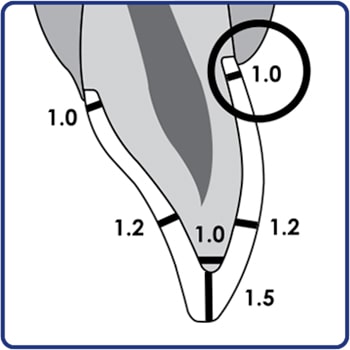
Posterior crown
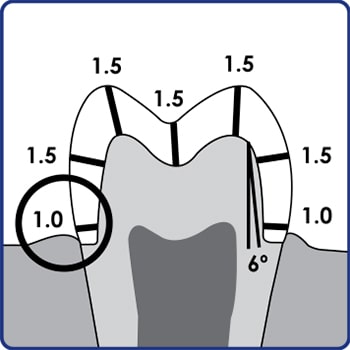
Veneers
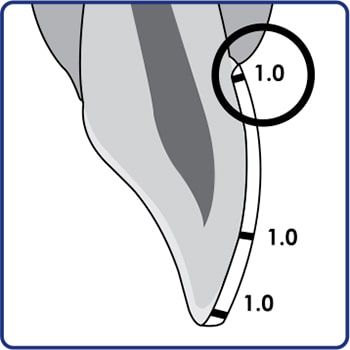
Onlay / Inlay

Partial crown
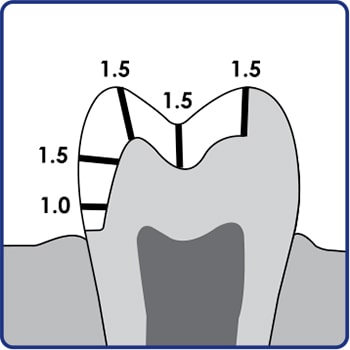
Instructions for anterior cases
Manage the expectation of your patient by making a wax up and requesting a stent over the wax up to be able to base your temporaries on the wax up. Send us an impressions of the temporaries and tell us what you would like to copy and what you would like to improve.
E.MAX
Contraindications:
- very deep subgingival preparations
- patients with severely reduced residual dentition
- parafunctions, e.g. bruxism
- provisional insertion/trial wear period
- bridges with a pontic beyond 5’s or bigger then 9mm
- cantilever bridges
- more then 3 unit bridges
- adjustments without polishing (please use appropriate burs only)
- always indicate if there is strong discolourations on the die
- don’t make sharp corner preparations
- for inlays/onlays the preparation margins must not be located on centric antagonist contacts
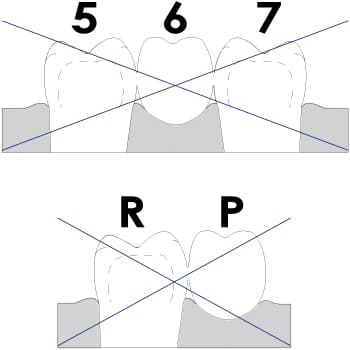
ZIRCONIA
Contraindications:
- provisional insertion/trial wear period
- adjustments without polishing (please use appropriate burs only)
- always indicate if there is strong discolourations on the die
- don’t make sharp corner preparations
- for veneer cases give us a “wrap around the incisal edge”
- check bonding procedures, and repeat these regardless of lab procedures
- wings are charged as unit
